Thailand has a wide range of transport options that make it very easy to travel through the country affordably and relatively quickly. Thailand has few domestic full-service and low-cost airlines, a comprehensive railway network, numerous bus companies, a massive minibus network and ferries providing easy access to all major islands.
Domestic Air Travel
THAI Airways and Bangkok Airways are the major full-service airlines on the internal flight network. Low-cost carriers such as Thai AirAsia, Thai Smile, Thai Lionair and Nok Air make traveling by air inside Thailand convenient for a very reasonable price. Domestic flights are well developed in Thailand.
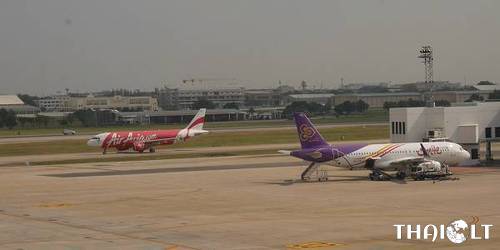
Fares with the low-cost carriers are often comparable to train or bus fares, especially if you book online far enough in advance. Airline tickets can be purchased online direct with the airlines or through travel agents and third-party flight agencies.
There are plenty of domestic airports to choose from.
Airports in Bangkok
- Suvarnabhumi Airport (BKK) – Thailand’s main hub mostly used for long-haul and full-service flights to Bangkok
- Don Mueang International Airport (DMK) – Bangkok’s second airport well connected with all Thailand regions and other Southeast Asian countries by low-cost carriers
Airports in Central Thailand
- Hua Hin Airport (HHQ) – airport used for connecting Thailand's Royal Beach Resort Hua Hin with Chiang Mai
- Mae Sot Airport (MAQ) – convenient for those planning overland border crossing to Myanmar
Airports in Northern Thailand
- Chiang Mai International Airport (CNX) – the main travel hub of Northern Thailand located in Chiang Mai
- Mae Fah Luang Chiang Rai International Airport (CEI) – Thailand’s northernmost airport can useful if you are visiting Chiang Rai, Golden Triangle or planning a trip to Luang Prabang in Laos by Mekong river
- Sukhothai Airport (THS) – airport connecting Historic Town of Sukhothai with Bangkok by full-service carrier
- Phitsanulok Airport (PHS) – more budget friendly option that can be used as a gateway to Sukhothai
- Lampang Airport (LPT) – airport connecting the third largest town in northern Thailand with Bangkok
- Mae Hong Son Airport (HGN) – time saving connection of small town Mae Hong Son and Chiang Mai
- Nan Nakhon Airport (NNT) - airport used for connecting sleepy town of Nan with Bangkok and Chiang Mai
- Pai Airport (PYY) - time saving connection of relaxed Pai and Chiang Mai
- Phrae Airport (PRH) – easier option for traveling from Chiang Mai to the capital of Phrae Province
Airports in Northeast Thailand
- Udon Thani International Airport (UTH) – the main travel hub of Isan region which is useful for overland border crossing to Vientiane, the capital of Laos
- Ubon Ratchathani Airport (UBP) – connection to one of the biggest Isan cities Ubon Ratchathani which is useful for overland border crossing to Pakse in southern Laos or northern Cambodia
- Buriram Airport (BFV) – connecting Bangkok with Buriram, used as the base for exploring ancient sandstone Khmer sanctuaries and temples in the surrounding area
- Khon Kaen Airport (KKC) – airport of one of the four major cities of Isan, Khon Kaen
- Loei Airport (LOE) – convenient for traveling to Chiang Khan, town famous among Thai tourists
- Nakhon Phanom Airport (KOP) - connection with Nakhon Phanom province which can be useful for overland border crossing to Laos
- Roi Et Airport (ROI) – connecting Bangkok with Roi Et, a town in Isan
- Sakon Nakhon Airport (SNO) – connecting Bangkok with Sakhon Nakhon, a town in Isan
Airports in Eastern Thailand
- U-Tapao International Airport (UTP) – airport conveniently connecting beach resort Pattaya and Ko Samet island with destinations in Southern, Northern and Northeast Thailand
- Trat Airport (TDX) – time saving option for traveling to Koh Chang and nearby islands from Bangkok
Airports in Southern Thailand
- Phuket International Airport (HKT) – the third busiest airport in the country serving as the main gateway to the biggest island of Thailand which is Phuket
- Hat Yai International Airport (HDY) – airport of the fourth largest city in Thailand Hat Yai which can be useful if planning a crossing overland to Malaysia
- Krabi International Airport (KBV) – connection for popular destinations in Krabi province such as Krabi, Railay, Koh Phi Phi and Koh Lanta
- Samui Airport (USM) – the main gateway to Koh Samui and nearby islands of Koh Phangan and Koh Tao
- Surat Thani Airport (URT) – the main airport of Surat Thani province that can be used as a more budget friendly option for reaching Koh Samui, Koh Phangan and Koh Tao
- Chumphon Airport (CJM) – more direct tourist gateway from Bangkok to the islands of the Gulf of Thailand, Koh Tao, Koh Phangan and Koh Samui
- Nakhon Si Thammarat Airport (NST) – connecting Bangkok and the capital of Nakhon Si Thammarat Province which is the second largest province in the south
- Narathiwat Airport (NAW) – used for reaching Deep Southern Thailand from Bangkok
- Ranong Airport (UNN) – gateway of Ranong town which can be used as a starting point of the trip to Koh Phayam or for a visa run by boat to Myanmar
- Trang Airport (TST) – airport used for reaching Trang and province’s archipelago in the Andaman Sea
Map of Airports in Thailand
Bangkok is the country’s main hub, though many of the low-cost carriers mostly use Don Mueang airport. You should allow three to four hours if the change of airports is needed for a connecting flight as it will be enough of time for catching a free shuttle bus between the airports.
Train Travel
Thailand’s rail network is operated by State Railways of Thailand (SRT). Train travel is largely safe, comfortable but slow. The trains tend to start their journey on time, but arrival most probably will be an hour or two later than scheduled.
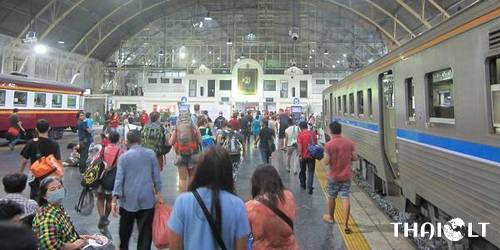
The main Bangkok train station as well as the center of train travel in Thailand is Hua Lamphong Railway Station.
Thailand’s rail network consists of four lines.
The Northern Line
- This line connects Bangkok with Chiang Mai via Ayutthaya, Lopburi, Phitsanulok and Lampang.
The Northeastern Line has two branches
- One branch is running from Bangkok to Ubon Ratchathani via Khorat and Surin.
- The other is linking the capital with Nong Khai via Khon Kaen and Udon Thani.
The Eastern Line also has two branches
- One branch is running from Bangkok to Aranyaprathet on the Cambodian border.
- The other is connecting Bangkok with Si Racha and Pattaya.
The Southern Line
- This line extends from Bangkok via Hua Hin, Chumphon and Surat Thani to Hat Yai, where it continues to Butterworth in Malaysia and makes it possible to travel down south to Singapore after changing the train. There are branches to Nakhon Si Tammarat and Trang on this line too.
- At Nakhon Pathom a branch of this line goes to Nam Tok via Kanchanaburi and the Bridge on the River Kwai.
Map of Thailand Railway Lines
Tickets for sleeper services should be purchased in advance. It can be done online or from stations at a maximum of 60 days in advance.
Fares depend on the class of seat and on the speed of the train. Hard third-class seats are much cheaper than buses. For longer journeys it would be wise to opt for the padded and reclining seats in second class. On long-distance trains, second-class berths, with day seats that convert into comfortable curtained-off bunks in the evening and first class air-con sleeping compartments should be the options to choose from.
For current timetables and fares check the website of State Railways of Thailand (SRT).
Inter-Town Buses
Buses might be the most convenient way of getting around Thailand. They are connecting most provincial capitals and then linking them with smaller towns by secondary services.
Few types of buses are used for inter-town traveling in Thailand:
- Fan-cooled ordinary buses usually can be seen on shorter routes in more remote parts of the country, but they are getting less common in the country. On most routes, including nearly all services out of Bangkok, regular air-con buses are used. These basic buses are inexpensive and generally run frequently during daylight hours. The ride can be slow because they pack as many people in as possible and stop often.
- First-class and VIP buses, offering express services, with fewer stops, are the best option for long-distance journeys. First-class buses have fewer seats and more leg room for reclining than regular buses. VIP buses have even fewer seats and are often positively luxurious. These buses are still reasonably priced and usually the more you pay the larger and more comfortable your seating is.
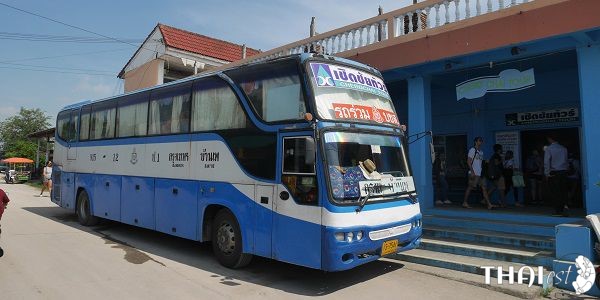
Tickets can be bought from the departure terminal at the bus station, online direct with the bus company or through travel agents. Tickets for the more popular routes should be booked a day in advance.
All provincial capitals have at least one dedicated bus station. They are usually located not in the central part of town and a ride with local bus, tuk tuk, songtaew or taxi is required for reaching it.
Ekkamai Bus Terminal is one of the busiest bus stations in Bangkok which is serviced by buses and minivans running to destinations in Eastern Thailand such as Rayong, Chonburi, Trat, Chanthaburi and tourist destinations such as Pattaya, Sriracha, Sattahip, Koh Chang or Koh Samet.
Minibuses
Another popular mean of transport in Thailand used all over the country is private air-conditioned minibuses. They run more frequently than inter-town buses and cover the distance faster, but they are often driven by maniacs at excessive speed and they can be uncomfortably cramped when full.
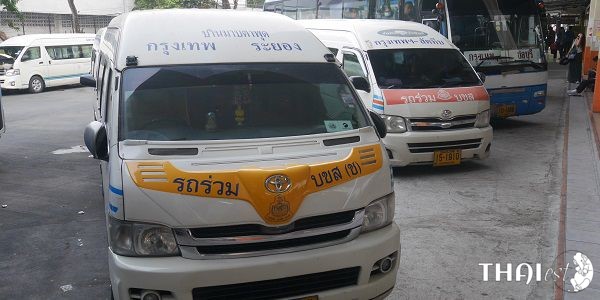
Minibuses are generally operating out of small offices or pavement desks in town centres but in some towns and cities authorities are trying to consolidate minibuses to central bus stations. The roads around Bangkok’s Victory Monument, once the busiest minibus pick-up point, were emptied of minibuses and they were moved to bus stations around Bangkok.
Some of minibus services have a timetable, but usually they depart when they’re full. Tickets are most easily bought at the minibus office or pavement desk. Fares are reasonable, usually about the same of air-con buses.
Songthaews
In rural areas, the bus network is often supplemented by songthaews (literally “two rows”). They are modified pick-up trucks or occasionally cattle-trucks, with two parallel bench seats installed on the rear part.
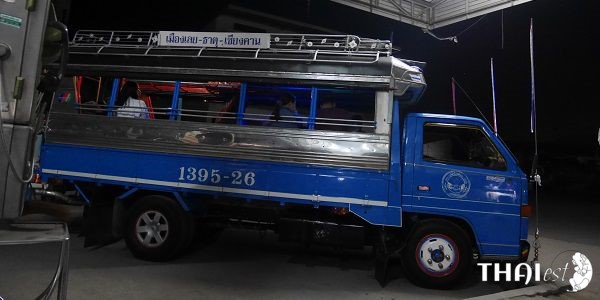
Songthaews usually have set routes from larger towns out to their surrounding suburbs and villages, and between small towns with no regular bus service.
Songthaews sometimes operate from local bus stations but in most towns they can be found parked near the market.
The cost of inter-town songthaews is comparable to that of air-con buses.
Ferries
Regular ferries connect all major islands with the mainland. Quality of vessels and safety standards can vary considerably but usually they are adequate.
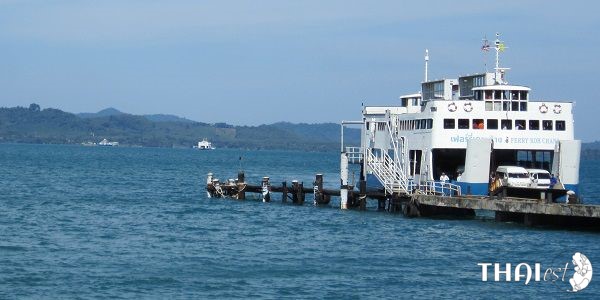
For the vast majority of crossings ticket can be simply bought on board. Tickets or the more popular routes can be booked online. Prices are quite low and fares tend to vary with the speed of the crossing.
Longtail Boats
While many of the more popular islands rely mainly on large passenger speedboats and ferries for transport, smaller islands can be reached almost exclusively by longtail boats. These boats can carry between eight and twenty passengers.
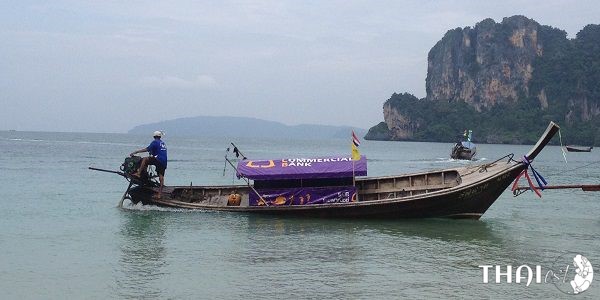
On popular fixed routes it is possible to wait until the boatman gets his wanted number of passengers and to get a fixed price for the route, otherwise chartering the whole boat is needed.
Tickets
Tickets for ground and sea transportation can be booked through this search form.
